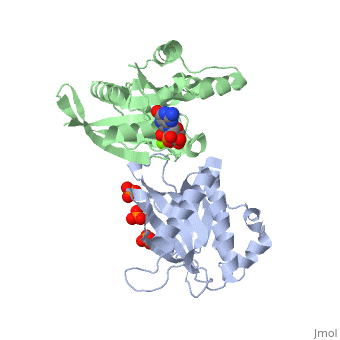Cancidas
From Proteopedia
FunctionCaspofungin is a cyclic peptide, isolated from the fermentation products of the fungus G. lozoyensis, that inhibits cell wall synthesis with inhibition of 1,3-β-glucan synthase. Inhibiting 1,3-β-glucan synthase leads to weakening of the cell wall and cell content leakage until death results. Caspofungin is unlike azole antifungal drugs as it triggers apoptosis of fungi and is not simply fungistatic. Many fungistatic drugs target the cell membrane rather than the cell wall or inhibit DNA and protein synthesis [1]. Members of the Aspergillus and Candida genera are most susceptible to the drug showing extreme susceptibility in hyphae extremities, sites of cell wall synthesis. Other pathogenic fungi that were previously believed to be saprophytic have also shown susceptibility [2].
StructureCaspofungin is composed of a cyclic hexapeptide with an N-terminus acylated by a carboxylic acid chain. The chemical structure contains a 3-hydroxy-proline residue, 3,4-dihydroxy-homotyrosine residue, 3-hydroxy-ornithine residue, 4-hydroxy-5-ethylenediamino-ornithine residue, 4-hydroxy-proline residue, and a threonine residue. It is a derivative of pneumoncandin B0 [3]. MechanismThe mode of action of caspofungin is unclear but it is believed that 1,3-β-glucan synthase synthesis is blocked by non-competitive inhibition. Glucan biosynthesis absence in host cells ensures good selectivity for pathogenic fungi. 1,3-β-glucan synthase is formed from the subunits Fks p, which binds UDP, and Rho 1 p, which binds GTP[4]. Medical Details/Additional InformationCandida glabrata is one of the most common fungal human pathogens that causes candidiasis, with symptoms such as thrush, and is found primarily in immunocompromised patients with HIV, undergoing chemotherapy, or have obtained an organ transplant[5]. Recently C. glabrata has become more resistant to azole drugs which target the fungal cell membrane so the use of cell wall synthesis inhibitors such as caspofungin has increased [6]. Mutations in Fks p glucan synthase subunit have allowed pathogenic fungi to obtain resistance to caspofungin hindering its potency[7]. Analysis of diversifying the structure of caspofungin showed the possibility of making the drug more potent to pathogenic fungi. By finding the optimal side chains and keeping the right lipopeptide as the hydrophobic core with the left lipopeptide as a hydrophilic structure, the compound becomes more active against Candida and Aspergillus [8]. Caspofungin and azole drugs alone have been ineffective against Cryptococcus neoformans, a fungus that causes a form of meningitis pneumonia like symptoms in immunocompromised patients. Studies that used an azole drug along with caspofungin showed that the fungal wall is affected and growth is hindered, however[9]. References
| ||||||||||||


